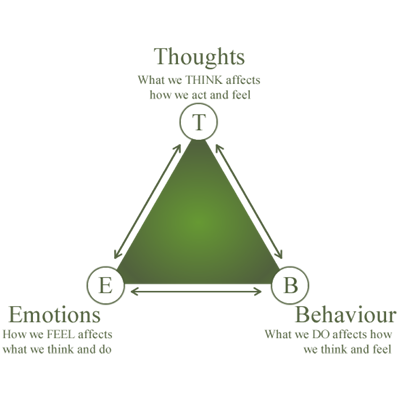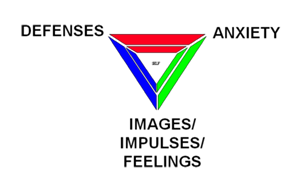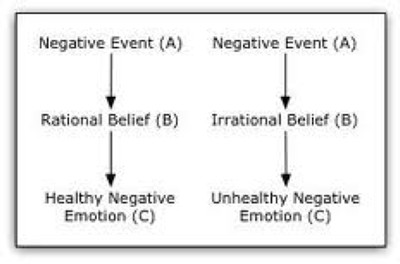Lesson 5: Interaction of Thought, Emotion, and Behavior
Attention

Learning Outcomes
Upon completion of this lesson's material, students will be able to:
- Students will learn to analyze behavior and implement common cognitive behavioral skills into their observations.
- Students will learn and demonstrate understanding of the Antecedents of behavior, the Behavior and the Consequence of Behavior as it applies to the Cognitive Behavioral aspects and Rational Emotive Behavioral aspects of Affect (emotions/feelings), Behaviors (actions), and Cognitions (thoughts).
- Students will be thoughtful about their own inner dialog and explain what it is and why using the Positive Psychology and CBT & REBT paradigms.
Teaching
From Positivity by Barbara Fredrickson
- The phrases and sentences we keep telling ourselves usually are or become our thoughts and emotions.
- Talk therapy aims to reveal error in logic.
- Our internal sentences shape our life.
- If we label an event a catastrophe, it will surely become one.
- Misery and depression are always states of mind. They are self-perpetuated.
- It is not events that determine your state of mind, but how you to decide to feel about the events. (David Burns)
- Feelings are not facts; you can change your feelings by changing your thinking. (David Burns)
- There is an arrogance in established patterns of thought. (Edward DeBono)
AUTOMATIC NEGATIVE THINKING (ANT) - The Killer of Happiness
- "Always/Never" Thinking
- Focusing on the NEGATIVE
- Fortune-Telling
- Mind Reading
- Thinking With Your Feelings
- GUILT BEATING
- LABELING
- PERSONALIZING
- BLAMING

COMMON THINKING ERRORS
All-or-Nothing Thinking:
You see things as black or white, never grey, e.g. if your performance falls short of perfect, you see yourself as a total failure.
Overgeneralization:
You see a single negative event as a never-ending pattern, e.g. "I messed up," "I never get anything right."
Mental Filter:
You pick out a single negative detail and dwell on it exclusively so that your view of reality becomes darkened, like a drop of ink that discolors an entire glass of water.
Disqualifying the Positive:
You reject positive experiences by insisting they "don't count" for some reason or other. In this way you continue to see everything as negative even when your everyday experiences contradict this.
Jumping to Conclusions:
You make a negative interpretation even though there are no definite facts that convincingly support your interpretation.
Mind Reading:
You think that someone is reacting negatively to you and you don't try to check this out with them.
The Fortune-Teller Error:
You anticipate that things will turn out badly and you feel convinced that your prediction is an already established fact.
Magnification (Catastrophizing) or Minimization:
You exaggerate the importance of things (such as your error or someone else's success), or you incorrectly shrink things until they appear tiny (your own desirable qualities or the other person's imperfections).
Emotional Reasoning:
You believe that your negative emotions reflect the way that things really are: I feel it, therefore it must be true."
"Should" (Must, Ought To) Statements:
You try to motivate yourself with "shoulds" and "shouldn'ts" as if you had to be whipped and punished before you could be expected to do anything. The emotional consequence are feelings of guilt, or being inadequate or wrong. When you tell others they "should" do something, you feel anger, frustration and resentment.
Labelling and Mislabeling:
This is an extreme form of overgeneralization. Instead of describing your error, you attach a negative label to yourself: "I'm a loser" instead of "I didn't do that well." When someone else's behavior annoys you, you judge him/her as a "loser."
Mislabeling is describing an event with harsh, emotional or judging statements.
Personalization:
You blame yourself for being the cause of some negative event for which you were not responsible. So, for example, if something goes wrong and affects others negatively, you take on the blame for it and feel bad.
The Ways to Happiness *****You Must Make Conscious Choices Every Day to Contest and Combat Automatic Negative Thinking until You have Developed the New Habit of Positive Thinking*****

- Kill the Automatic Negative Thinking (ANT)
- Surround Yourself with People Who Provide POSITIVE BONDING
- Build People SKILLS to Enhance LIMBIC BONDS
- Recognize the Importance of Physical Contact
- Surround Yourself with GREAT SMELLS
- Build a Library of Wonderful MEMORIES and ACCOMPLISHMENTS
- Try Physical EXERCISE
- Watch Your Limbic Nutrition (Google it!)
-- Quoted from Change Your Brain, Change Your Life by Daniel G. Amen, MD
Click HERE to view this directly on YouTube
Assessment
Lesson 5 Assignment
Use the REBT and CBT models, along with what you are learning from Authentic Happiness to describe your inner-dialog. Complete the Exercise starting on page 100 in Authentic Happiness and complete the following REBT Exercise
http://www.rebtnetwork.org/library/shf.html
THEN write a 1000 word essay regarding your understanding of these tools and the relationship thinking habits have on your overall sense of well-being.
Lesson 5 Discussion
Watch the following video and discuss your thoughts, feelings, observations and comments. Don't forget to respond to others!
Click HERE to view this directly on YouTube